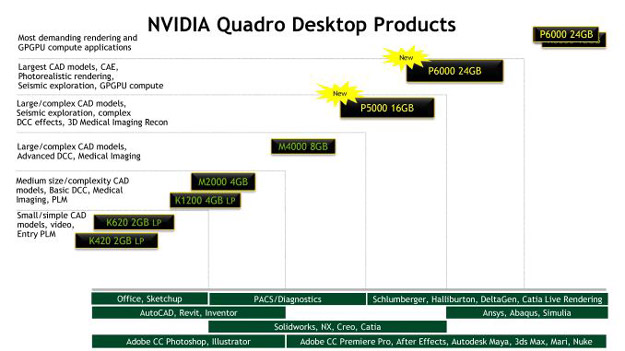NVIDIA Unleashes Beastly Quadro P6000 With 24GB GDDR5X, 3840 CUDA Cores For Pro Graphics Market
The Quadro P6000 is even a step beyond the Titan X, with 3840 CUDA cores and 12 TFLOPs of compute power at its disposal. NVIDIA says that all of this power on tap will allow the Quadro P6000 to “manipulate complex designs” up to two times faster than its predecessor. You won’t find High Bandwidth Memory here (aka HBM2), but the professional graphics card does pack in a massive 24GB of 10GHz GDDR5X memory. HBM2 is reserved for NVIDIA’s flagship Tesla GPUs.

Stepping a few rungs down on the professional graphics ladder is the Quadro P5000 with its 2560 CUDA cores and 16GB of GDDR5X memory. However, both cards come with four DisplayPort 1.4 ports and one DVI connector. Both cards can also support up to four displays at 4092x2160 @ 120Hz or four displays at 5120x2880 @ 60Hz.
“NVIDIA Quadro with the latest Pascal GPU architecture is truly designed for professionals working with extremely large and complex datasets,” says Rob Herman, GM and Executive Director for Lenovo's Workstations. “The performance boost, coupled with our ability to support up to 3 P6000 class GPUs in the ThinkStation P910, makes it ideal for our workstation and mobile users across a range of industries. Together, Lenovo and NVIDIA Quadro continue to raise the bar for professional graphics.”
"Often our artists are working with 50GB or higher datasets,” adds Pixar CTO Steve May. “The ability to visualize scenes of this size interactively gives our artists the ability to make creative decisions more quickly. We’re looking forward to testing the limits of Pascal and expect the benefits to our workflows to be huge.”

NVIDIA says the Quadro P6000 and P5000 will launch this October.
In addition to the new 16nm Pascal-based Quadro cards, NVIDIA also announced that it is extending its VRWorks SDK to include the acceleration of 360-degree video stitching. With VRWorks 360 Video, videographers will be able to combine footage from up to 32 cameras and "stitch" them into a single 360-degree video. Using the SDK, it’s possible to achieve GPU-accelerated decode, calibration, stitching, equalization and encode. And in case you were wondering, the VRWorks 360 Video SDK is fully compatible with GPUDirect for Video.
NVIDIA has also updated its Iray plug-in to include support for 3D panoramas (among other things):

Iray support is also coming to the DGX-1 server later this fall. If you recall, the DGX-1 features up to 8 Tesla P100 accelerators and is purpose-built for deep learning. Looking further out, Iray will add support for NVLink technology next year. NVIDIA also announced that OptiX 4.0 will be released this week, adding support for both the DGX-1 and NVLink.



